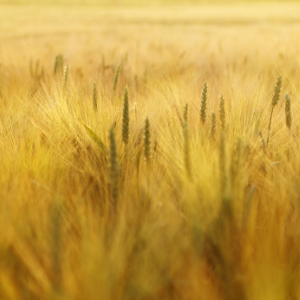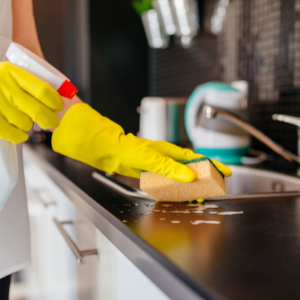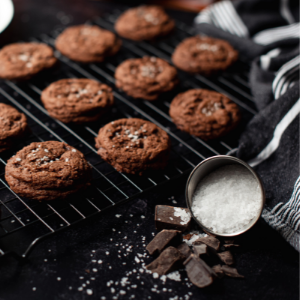With restaurants promoting gluten-free meals and products with gluten-free labels lining store shelves, it is impossible not to want to learn about the gluten-free movement. Though it might appear like another trend, gluten-free dishes and products are a dietary necessity for those with gluten sensitivities. Since gluten is mostly found in baked goods, foodservice establishments are now offering customers options to help them stick to their gluten-free diets. However, as many have found, gluten-free baking is different and more difficult than traditional baking. To learn more about gluten-free baking, follow these tips so you can become an expert.
Why Is Gluten Bad For You?
Those with celiac disease, gluten intolerance, wheat allergy, or ataxia can suffer from health problems if they consume gluten. If no gluten sensitivities are present, it will not cause any harm when eaten.
 What Foods Are High In Gluten?
What Foods Are High In Gluten?
Grains such as wheat, barley, and rye are the primary carriers of gluten protein. It can also be found in wheat relatives such as spelt and kamut. Although oats are naturally gluten-free, the production process contaminates oats with gluten. Vanilla extract, baking powder, starch thickeners, and some sugars might also contain gluten which is why it’s important to always check for labels that say 100% gluten-free.
What Foods Are Gluten-Free Alternatives?
If you’re looking for gluten-free foods, try fruits, vegetables, seafood, meats, and products that are labeled gluten-free. For cooking with gluten-free ingredients, try these substitutes:
- Pasta - rice noodles, quinoa pasta, lentil pasta, kelp noodles, and veggie noodles
- Grains - rice, cauliflower rice, quinoa, and buckwheat
- Flour - coconut flour, rice flour, cornmeal, and almond flour
What Happens To Your Body When You Stop Eating Gluten?
While some might say that going gluten-free leads to weight loss or an increase in energy, there aren’t enough studies done to support these claims. Because gluten-free bread is made with certain types of flour, a lack of gluten can cause nutritional deficiencies in the body such as low fiber, iron, vitamin B, and folic acid.
Tips For Gluten-Free Baking
Gluten-free baking is a lot harder than traditional baking because gluten protein is what gives baked goods their structure. Bread without gluten or any gluten substitute will be thick and crumbly when it comes out of the oven. You can’t substitute wheat flour with any type of gluten-free flour because the end result will be very different than what you had initially expected. If this is your first time trying gluten-free baking, start off with something easy like pancakes or cookies. In case your foods don’t come out the way you wanted them to, don’t be too hard on yourself. This is a learning process and you are allowed to make mistakes.
1. Set Your Expectations
Remember, gluten-free recipes will not taste the same as wheat recipes. To get familiar with the taste of gluten-free products, go out to restaurants and try some desserts so you can have a better idea of what good gluten-free food is supposed to taste like.
You should also be familiar with the characteristics of gluten-free bread. Since they don’t contain gluten, they are more crumbly and become stale quicker than their wheat-based counterparts.
 2. Clean Before You Bake
2. Clean Before You Bake
Before laying a hand on any ingredients, clean every surface and tool you are going to work with. Even the tiniest wheat crumb can contaminate your dishes. Designate an area in your kitchen where you can prepare and keep allergen-free foods and ingredients away from normal ingredients.
3. Safely Store Gluten-Free Ingredients
Be sure to keep gluten-free ingredients away from regular ingredients so that you don’t accidentally mix the two up. Also, always check the expiration date of gluten-free ingredients since they have short shelf lives.
4. Closely Follow Recipes
Read your recipe instructions before getting started. When it comes to gluten-free baking, you have to follow directions to a T. Anything that is the slightest bit off can ruin the dish. You can’t get away with making any mistakes with this type of baking.
It is recommended that you buy an oven thermometer to make sure that your oven is not running hot or cold. The slightest degree off can have a great effect on the results of your recipe.
When placing your desserts in a preheated oven, always position them in the center unless instructed otherwise. During the baking process, keep an eye on your creation to check when it is ready to be taken out. Gluten-free foods are baked at lower temperatures and for a longer period of time when compared to traditional recipes.
5. Accurately Measure Ingredients
It is incredibly important to measure every ingredient carefully, especially flour. No matter what type of gluten-free flour you pick, you’re going to have to weigh it on a scale rather than with a measuring cup. This is because gluten-free flour is finer than wheat flour and if you don’t add the exact amount of flour, your creation can end up being too thick or lay flat.
For acute exactness, use a glass measuring cup for wet ingredients, and regular measuring cups or teaspoons for dry ingredients other than flour. When using measuring cups and spoons, level off the top by using the back edge of a knife. For liquid ingredients, place the measuring cup on a flat, solid surface, then pour the liquid into the measuring cup. Make sure you are eye-level with the measuring lines.
 6. Cool Baked Goods As Soon As Possible
6. Cool Baked Goods As Soon As Possible
So your creations won’t get soggy, place them on a wire rack as soon as you take them out of the oven. If you leave them in the baking pan, the steam will get trapped inside and fill them with moisture.
7. Quickly Store Leftovers
Gluten-free bread stays soft and moist during its first day out of the oven, but if you have any leftovers, be sure to put them in the freezer. This has to be done because they dry out after the first day. When ready to be eaten, simply thaw and toast them.
Don’t Be Afraid To Experiment
Once you’ve had enough practice and feel more confident with handling gluten-free ingredients, feel free to experiment with your dishes. Try different gluten-free flour brands, add in fruits and extracts to increase the flavor, or add texture. Experimenting is highly recommended since gluten-free baked goods have a certain flavor and it can be difficult getting your creations to taste the way you want them to. Don’t be afraid and take a chance, you might just be baking the next best thing.









